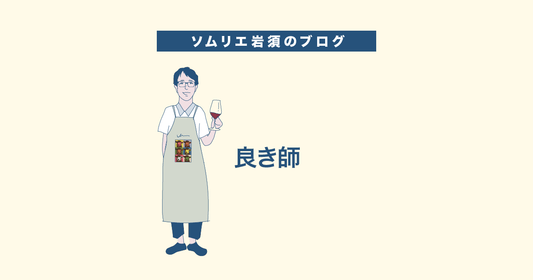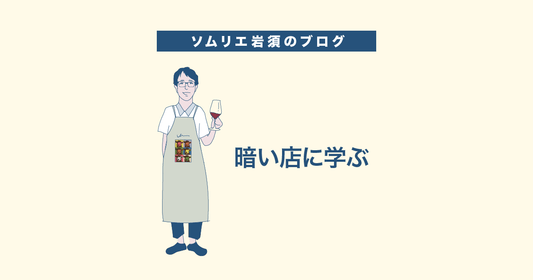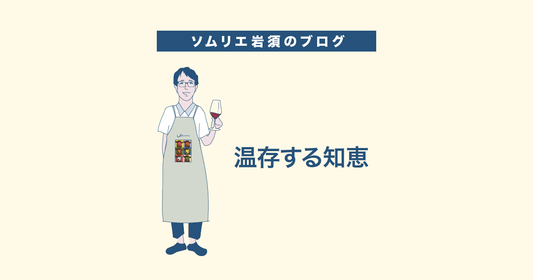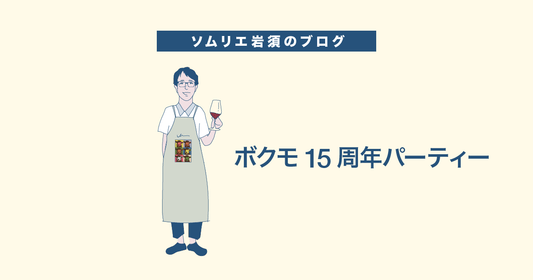
"I found something really great, but at the same time I was a little confused."
The feeling I got from holding it every day
If you work with wine, there's one thing you come into contact with every day : wine glasses .
The store has been open for over 10 years, and I wash and wipe wine glasses every business day.
Over the years I have bought, used, washed, wiped, and sometimes broken many different types of glass.
What I naturally developed in that environment was the ability to roughly tell the grade of a wine glass when I see it.
There aren't as many different types of wine glass manufacturers as there are wine manufacturers.
Among these, the number of products that are distributed in the Japanese market and used in stores is significantly limited.
Some of the most well-known brands include Riedel, Schott Zwiesel, Lobmeyer, Zalto, Baccarat, Chef & Sommelier, Spiegelau, Strötzl, and Toyo Sasaki Glass.
Many of these manufacturers have their logo on the base, which makes it easy to identify the brand.
Furthermore, the models made by each manufacturer have "characteristic shapes that are recognizable at a glance," making them fairly easy to remember (though some models don't have many distinctive features, that lack of distinctiveness is in fact a characteristic of them).
Therefore, once you have memorized the patterns of glass shapes, you will be able to roughly determine the grade of glass by looking at information in catalogs or commercial purchasing sites.
Based on that experience, you will develop a rough sense of market prices, such as "With this thinness and beautiful shape, it would probably cost 5,000 yen," or "This one isn't that thin, so 1,500 yen would be appropriate."
(By the way, in our store, we have a rule that each glass is limited to 2,000 yen. This is to ensure that the quality of the store matches that of the glasses.)
Just the other day, I came across a pair of glasses that I thought were way outside the market price I was familiar with.
This is Daiso's thin glass, 500ml.

What a thing to say.
The price is 100 yen excluding tax.
Honestly, 300 yen is cheap for this. I would buy it for 500 yen. I wouldn't think 800 yen is too expensive.
First of all, I was surprised at how thin it was.
The transparency is also high. It's wonderful.
It's based on the format created by Oh.
Although most people tend to think of wine glasses as those with stems, stemless wine glasses are already widely used in the world of wine.
This is thought to be largely due to the influence of the Riedel O, a tumbler-style stemless wine glass released in 2004 by Riedel, a leading wine glass brand.
O has managed to strike a balance between authenticity and casualness, and has won fans around the world, especially in the United States.
He has been a regular player at my club, Rockmo, for a long time.
On Riedel's official website, Oh is described as follows:
Since it does not have a stem, you can enjoy wine in any style, even if you are not sitting properly at the dining table, while relaxing on the sofa or cooking in the kitchen. In addition, it is small, lightweight, durable and easy to carry, so it is perfect for outdoor events such as picnics and barbecues, where you can enjoy wine at your leisure.
Very easy to understand explanation.
As expected from a major company.
It's probably a promotional copy carefully crafted by a copywriter.
However, this description also applies to the 500ml thin glass from Daiso. If I were a copywriter, I would be angry because it fits the Daiso glass so perfectly.
It's easy to carry, doesn't take up much space, there's no need to worry about the legs breaking, and you can enjoy it outdoors with authentic glasses.
Well, the rim (the part that touches your mouth) has a slight bulge for reinforcement, and the bottom is uneven, so of course there is a difference in quality compared to the original Oh.
But what's particularly noteworthy is how thin it is.
This is something.
I was amazed to find that this could be achieved at roughly one-twentieth the price of Riedel.

I took a photo with " MATUA SAUVIGNON BLANC ", a popular brand of New Zealand wine. The amount of wine is 100ml.
The volume of the bowl that stores the fragrance is also perfect.
In terms of size, Riedel O's Cabernet/Merlot version is 600ml, while the Viognier/Chardonnay version is 320ml.
Daiso's thin glasses come in one size, 500ml (as far as I've seen).
Compared to the original, you can see that it is a little larger.
It has a slightly long and slender shape, but it has a large capacity of 500ml, so it has a good surface area when filled with 100ml of wine.
Therefore, the amount of fragrance that evaporates from it is sufficient.
By placing your nose inside the bowl, you can fully detect the wine's complex aromas.
In other words, it is perfectly suited to high-quality wines with delicate aromas.
It's really amazing.
Rim bulge
By the way, the easiest way to distinguish between an "authentic wine glass" and a "non-authentic wine glass" is by the "thinness of the glass" and the "bulging rim" mentioned earlier.
Anyone can tell how thin the glass is by looking at it and holding it.
The problem with a bulging rim is that it affects the way the wine flows from the glass to your mouth.
The protruding rim, which is reinforced to prevent cracking, acts like a dam to hold back the wine when you tilt the glass to drink it.
The liquid just collects there.
From there, you need to tilt the glass further to allow the wine to overflow over the dam on the rim and forcefully enter your mouth.
In other words, if there is a dam on the rim, it becomes difficult to control the amount of wine that goes into your mouth, and it makes it easier for the wine to go right into your mouth.
On the other hand, if the rim is not raised at all, the wine will flow straight into your mouth the more you tilt the glass. This makes it easier to control the amount and speed of the wine.
That's why, when it comes to wine, which is enjoyed in small sips and with delicate flavors, glasses without rim dams are the norm, allowing you to delicately adjust the amount of wine that enters your mouth.
With that in mind, what about these Daiso glasses?

There is a dam.
However, compared to other 100 yen store glasses I have come across , the body is much lower .
I actually poured wine into it and tried drinking it, and it didn't feel strange like the wine was pouring in all at once.
It's very close to the feel of damless glass.
Furthermore, this small dam is rounded, so it feels soft to the touch when it hits your mouth.
High-end glasses without rims can sometimes have an edgy feel on the mouth, but this is not the case with the Daiso glasses, and they fit comfortably in the mouth.
This is a very good impression.
I think it also affects the way you perceive wine.
I think it might help improve the mellowness of the flavor .
However, I'm worried that it's too expensive...
The cost performance of this glass is truly remarkable.
I once had a bad experience when I received a 4,000 yen wine glass as a gift and broke it the next day.
Yes, any glass will break, and that's awful.
To make matters worse, the liquid in a wine glass is an alcoholic drink called wine.
This is fine if someone else can wash it for you, but if you're enjoying wine at home, you may end up washing the glass with your alcoholic body.
This is a red card. If there was a referee, you would be sent straight to bed.
The more drunk you are, the more overconfident you are. The more drunk you are, the more your hands go awry.
The slimy detergent caused it to slip and shatter. I used too much pressure while wiping it and it creaked. I let it come into contact with other dishes too hard and it cracked.
I've done them all.
As I type on the keyboard, that unpleasant feeling comes back to me vividly.
The golden rule is to rinse the wine glass, add a small amount of water, and set it aside.
You should wash it the next day.
I would like this to be included in the Sommelier Association's textbooks.
But then there's this 500ml thin glass from Daiso.
It costs 100 yen.
It's a price that makes you think, "Oh well, it can't be helped," even if it breaks.

(By the way, here's a technique to prevent it from slipping when you hold it. If you place your pinky finger on the bottom, it will give you a better grip.)
Stemless glasses don't take up much space, so you can buy a lot of them. If one breaks, you can just buy another one.
It is human nature to treat cheap things carelessly.
Even if you handle it roughly and it breaks, it'll be okay to try the next one.
But... I think this.
I wonder what the manufacturer of this glass thinks.
When I work with wine, I sometimes imagine what kind of work the person who made that wine does based on the wine poured into a glass.
For example, in the case of a wine with a traditional flavor, a father, his son, and his wife work together to preserve the flavor of that generation.
In the case of a slightly cloudy wine, a son who returned from traveling the world wanted to make his own wine and adopted the trendy natural style. His father opposed it at first, but now reluctantly accepts it.
Some of this is just my own fantasy, but fragments of stories I've heard when I met creators in Japan and overseas start to connect in my head.
So, I can't help but think about the producer of this thin 500ml glass.
The product tag says MADE IN POLAND .

Parent : "Hey, we've received a huge order from Japan. But will they deliver it at such a low price?"
Child : "Dad, I think our technology can work. This is a great opportunity. After all, Japan is a country that is highly information-driven, right? Let's use this opportunity to let people know about our technology. Then our reputation will spread from Japan, and we might even be noticed by the global wine industry."
Having taken on the job in this way and earned some money, the father and son traveled all the way from Poland to Japan.
Parent : "Now, which store sells our glasses?"
Child: "Dad, look here. Our glasses were placed here. Isn't this a general store? They're all 100 yen? Are our glasses worth the same as a ballpoint pen? Do people who like wine really come here and understand our skills?"
Parent: "Apparently, our glasses are worth about this much in Japan. I wonder who is being pleased by our technology, which we have worked so hard to develop..."
Child : "Dad...if only I hadn't said that then (tears)"
No! This is bad!
The story is completely fictional, but...
However, I would like to think about this from the perspective of manufacturing.
The makers are craftsmen.
Naturally, these glasses are probably machine-made and not handmade, but they still contain the technology of Poland's local industry.
The people who support this technology are undoubtedly the craftsmen (in my fantasy, a father and son who have run a glass factory for generations) .
The products made by these craftsmen are not placed in a sales area staffed by staff who are passionate about wine and glasses, but rather in large stores that handle a huge variety of miscellaneous goods, where they are sold at extremely low prices, just like the other products.
I thought that if they knew about it, it might hurt their pride a little.
Anyone who takes pride in their work will do so with the hope that their products will reach someone who will appreciate the value of what they have created.
I imagine people saying , "The person who made these glasses is amazing," and I think to myself , "Okay, I'll do my best today too, so that someone can enjoy a happy dinner table." as I work hard.
I believe that craftsmen who wish for the happiness of their end users are those who have the heart to create good things.
So I wonder if this price is really okay.
In the end, I'm not sure whether I want to recommend this glass or not, but what I want to say is,
"If price competition becomes too fierce, there is a danger that the spirit of craftsmanship will be lost."
I think sometimes it's important to keep that in mind when choosing products.
In today's world where clear value is everything, is this a bit naive?
However, in the wine industry where I work, this ``dangerous'' phenomenon is clearly occurring.
When there is too much mass-produced, cheap wine on the market, producers of truly delicious, handmade wine suffer.
That's the case with Chilean wines these days.
There are some brands that are priced too cheaply, which has led to the image that Chile = cheap.
Authentic, handmade Chilean wines struggled, and as a result, sales and the image of Chilean wine as a whole declined.
I'm a bit disappointed.
Since it's an economic activity, cheapness is important, but wine and glasses also have a cultural aspect to them.
Efforts must also be made to ensure that this culture continues in a healthy state.
I think that first of all, people who like that culture have to gradually educate people that "good value for money products are good, but products with a solid background are also good." That's what I think now.
Finally, as a sign of respect for Riedel, a leader in glass culture, I would like to close by providing a link to the Riedel O online shop.
And here is an article I wrote about how to choose wine glasses.
▶ [Drinking wine] Part 1. About wine glasses
See you later.





